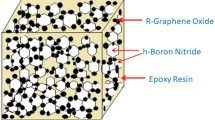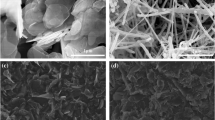Abstract
The rapidly growing third-generation wide-band-gap semiconductor electronic device industry urgently requires high-temperature-resistant packaging materials. However, the epoxy molding compound materials cannot suffer the high-temperature working condition due to the intrinsic molecular chain structure of epoxy materials (EP). In this paper, bisphenol A-type cyanate (BADCy) with triazine ring structure was introduced into EP to improve its heat resistance. The curing reaction as well as the curing mechanism has been clearly revealed for BADCy/EP with different contents of BADCy according to the Fourier transform infrared spectroscopy (FTIR) and differential scanning calorimeter (DSC) results. In the whole copolymer system, the copolymer at higher BADCy concentration (50–60 mol%) achieved the highest crosslink density (12.8 × 10–3 mol/cm3), thus, showing excellent glass transition temperature (> 200 °C) and thermal decomposition temperature(T5% > 400 °C). The heat resistance and electrical insulation property of BADCy/EP system have been systematically investigated, and a balance between high heat resistance and good electrical insulation are achieved at 66 mol% BADCy content, where the glass transition temperature reaches 215 °C, which is 73 °C higher than that of the EP system of anhydride copolymer. The volume resistivity of 1.5 × 1015 Ω·m and dielectric constant of 3.3 is obtained, indicating excellent electrical insulation and dielectric properties of BADCy/EP. This work provides a facile and efficient strategy to improve the overall properties of EP by optimizing the molecular chain structure.








Similar content being viewed by others
Data availability
The datasets generated during and/or analyzed during the current study are available from the corresponding author on reasonable request.
References
H. Lee, V. Smet, R. Tummala, IEEE Trans. Emerg. Sel. Top. Power Electron. (2020). https://doi.org/10.1109/jestpe.2019.2951801
X. She, A.Q. Huang, O. Lucia, IEEE Trans. Ind. Electron. (2017). https://doi.org/10.1109/Tie.2017.2652401
X. Ding, Y. Zhou, J. Cheng, CES Trans. Elect. Mach. Syst. (2019). https://doi.org/10.30941/cestems.2019.00008
Q. Li, F.Z. Yao, Y. Liu, Annu. Rev. Mater. Res. (2018). https://doi.org/10.1146/annurev-matsci-070317-124435
Y.Y. Yao, G.Q. Lu, D. Boroyevich, IEEE Trans. Compon. Pack. Manuf. Technol. (2015). https://doi.org/10.1109/Tcpmt.2014.2337300
C. Chen, CPSS Trans. Power Electron. Appl. (2017). https://doi.org/10.24295/cpsstpea.2017.00017
C. Wong, Electronic Applications (1988). https://doi.org/10.1007/BFb0025903
A. Inamdar, Y.H. Yang, A. Prisacaru, Polym. Degrad. Stab. (2021). https://doi.org/10.1016/j.polymdegradstab.2021.109572
J. Li, K. Mohanalingam, O. Gupte, 2021 IEEE 71st Electronic Components and Technology Conference (ECTC) IEEE (2021)
B.L. Xue, R. Tang, D.W. Xue, Ind. Crops Prod. (2021). https://doi.org/10.1016/j.indcrop.2021.113583
H. Jiang, L. Sun, Y.R. Zhang, Eur. Polym. J. (2018). https://doi.org/10.1016/j.eurpolymj.2018.09.020
M.H. Wu, X. Liu, Y.B. Zhou, Chem. Eng. J. (2022). https://doi.org/10.1016/j.cej.2022.135435
Y. Tian, Q. Wang, L. Shen, Chem. Eng. J. (2020). https://doi.org/10.1016/j.cej.2019.123124
L.Q. Reyes, J. Zhang, B. Dao, J. Appl. Polym. Sci. (2020). https://doi.org/10.1002/app.48874
J. Ueyama, R. Ogawa, K. Ota, ACS Appl. Polym. Mater. (2021). https://doi.org/10.1021/acsapm.1c00995
J. Li, C. Ren, Z. Sun, ACS Appl. Mater. Interfaces (2021). https://doi.org/10.1021/acsami.0c20537
J.X. Li, C. Ren, D. An, Polymer (2020). https://doi.org/10.1016/j.polymer.2020.122454
X. Li, Y. Zhou, Y. Bao, Ind. Eng. Chem. Res. (2022). https://doi.org/10.1021/acs.iecr.2c00048
R.J. Iredale, C. Ward, I. Hamerton, Prog. Polym. Sci. (2017). https://doi.org/10.1016/j.progpolymsci.2016.12.002
N. Liu, H. Wang, B. Ma, Compos. Sci. Technol. (2022). https://doi.org/10.1016/j.compscitech.2021.109252
Y. Ji, Y. Zhang, P. Wang, Fibers Polym. (2021). https://doi.org/10.1007/s12221-021-9142-x
F. Wu, B. Song, J. Hah, J. Polym. Sci. Pol. Chem. (2018). https://doi.org/10.1002/pola.29214
L. Tang, J. Dang, M.K. He, Compos. Sci. Technol. (2019). https://doi.org/10.1016/j.compscitech.2018.11.018
B.H. Wang, L.M. Liu, G.Z. Liang, J. Mater. Chem. A (2015). https://doi.org/10.1039/c5ta07611k
J. Bauer, M. Bauer, Acta Polym. Sin. (1990). https://doi.org/10.1002/actp.1990.010411006
M.R. Kessler, Wiley Encyclopedia of Composites (2011). https://doi.org/10.1002/9781118097298.weoc062
S. Goyal, M.J. Forrester, D. Coverdell, Macromolecules (2021). https://doi.org/10.1021/acs.macromol.1c01410
T. Zheng, H. Xi, Z.X. Wang, Polym. Test. (2020). https://doi.org/10.1016/j.polymertesting.2020.106781
H. Sun, Y.Y. Liu, Y.S. Wang, J. Appl. Polym. Sci. (2014). https://doi.org/10.1002/App.40711
J. Broughton, V. Smet, R.R. Tummala, J. Electron. Packag. (2018). https://doi.org/10.1115/1.4040828
J.T. Miao, L. Yuan, Q.B. Guan, ACS Sustain. Chem. Eng. (2017). https://doi.org/10.1021/acssuschemeng.7b01222
I.M. Barszczewska-Rybarek, A. Korytkowska-Walach, M. Kurcok, Acta Bioeng. Biomech. (2017). https://doi.org/10.5277/ABB-00590-2016-01
W.F.A. Su, C.-M. Chuang, J. Appl. Polym. Sci. (2002). https://doi.org/10.1002/app.10887
R. Li, X. Yang, J. Li, Mater. Today Phys. (2022). https://doi.org/10.1016/j.mtphys.2021.100594
H.M. Fang, S.L. Bai, C.P. Wong, Compos. A (2017). https://doi.org/10.1016/j.compositesa.2017.04.018
J.T. Wan, J.Q. Zhao, B. Gan, ACS Sustain. Chem. Eng. (2016). https://doi.org/10.1021/acssuschemeng.6b00479
M. Awais, X. Chen, Z. Hong, Compos. Sci. Technol. (2022). https://doi.org/10.1016/j.compscitech.2022.109576
P. Preetha, M.J. Thomas, IEEE Trans. Dielectr. Electr. Insul. (2011). https://doi.org/10.1109/Tdei.2011.6032821
Q.Y. Zhang, X. Chen, B. Zhang, Matter (2021). https://doi.org/10.1016/j.matt.2021.04.026
Funding
This work was supported by the National Natural Science Foundation of China (Nos. U20A20308, 51977050, 52277024), Heilongjiang Provincial Natural Science Foundation of China (ZD2020E009), China Postdoctoral Science Foundation (Nos. 2021T140166, 2018M640303), University Nursing Program for Young Scholars with Creative Talents in Heilongjiang (No. UNPYSCT-2020178, UNPYSCT-2020180).
Author information
Authors and Affiliations
Contributions
All authors contributed to the study conception and design. Material preparation, data collection, and analysis were performed by XZ, QC, CT, HL, CZ, and ZL. The first draft of the manuscript was written by XZ, and revised by TZ. QC and TZ supervised this work. All authors commented on previous versions of the manuscript. All authors read and approved the final manuscript.
Corresponding author
Ethics declarations
Conflict of interest
There are no conflicts to declare.
Additional information
Publisher's Note
Springer Nature remains neutral with regard to jurisdictional claims in published maps and institutional affiliations.
Rights and permissions
Springer Nature or its licensor (e.g. a society or other partner) holds exclusive rights to this article under a publishing agreement with the author(s) or other rightsholder(s); author self-archiving of the accepted manuscript version of this article is solely governed by the terms of such publishing agreement and applicable law.
About this article
Cite this article
Zhang, X., Chi, Q., Tang, C. et al. Achieving high-temperature resistance and excellent insulation property of epoxy by introducing triazine ring structure. J Mater Sci: Mater Electron 34, 638 (2023). https://doi.org/10.1007/s10854-023-10078-6
Received:
Accepted:
Published:
DOI: https://doi.org/10.1007/s10854-023-10078-6




